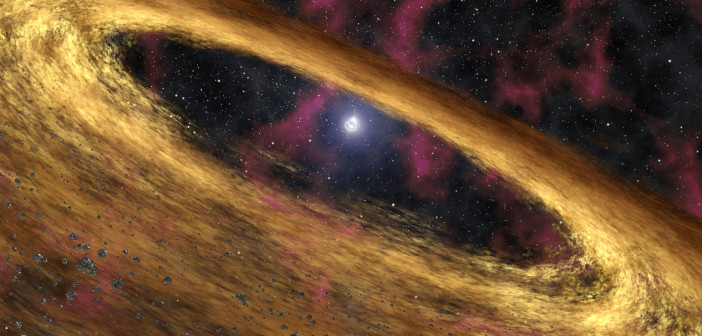Did you know that the very first exoplanets ever confirmed were found around a pulsar? The precise timing measurements of pulsar PSR 1257+12 were what made the discovery of its planetary companions possible. Yet surprisingly, though we’ve discovered thousands of exoplanets since then, only one other planet has ever been confirmed around a pulsar. Now, a team of CSIRO Astronomy and Space Science researchers are trying to figure out why.
Formation Challenges
The lack of detected pulsar planets may simply reflect the fact that getting a pulsar-planet system is challenging! There are three main pathways:
- The planet formed before the host star became a pulsar — which means it somehow survived its star going supernova (yikes!).
- The planet formed elsewhere and was captured by the pulsar.
- The planet formed out of the debris of the supernova explosion.
The first two options, if even possible, are likely to be rare occurrences — but the third option shows some promise. In this scenario, after the supernova explosion, a small fraction of the material falls back toward the stellar remnant and is recaptured, forming what is known as a supernova fallback disk. According to this model, planets could potentially form out of this disk.
Disk Implications
Led by Matthew Kerr, the CSIRO astronomers set out to systematically look for these potential planets that might have formed in situ around pulsars. They searched a sample of 151 young, energetic pulsars, scouring seven years of pulse time-of-arrival data for periodic variation that could signal the presence of planetary companions. Their methods to mitigate pulsar timing noise and model realistic orbits allowed them to have good sensitivity to low-mass planets.
The results? They found no conclusive evidence that any of these pulsars have planets.
This outcome carries with it some significant implications. The pulsar sample spans 2 Myr in age, in which planets should have had enough time to form in debris disks. The fact that none were detected suggests that long-lived supernova fallback disks may actually be much rarer than thought, or they exist only in conditions that aren’t compatible with planet formation.
So if that’s the case, what about the planets found around PSR 1257+12? This pulsar may actually be somewhat unique, in that it was born with an unusually weak magnetic field. This birth defect might have allowed it to form a fallback disk — and, subsequently, planets — where the sample of energetic pulsars studied here could not.
Citation
M. Kerr et al. 2015 ApJ 809 L11 doi:10.1088/2041-8205/809/1/L11

1 Comment
Pingback: Binary Black Holes Powering a Quasar, Astronauts in Bed, Saturn’s F Ring, Planets Orbiting Pulsars, Experts Under Pressure and More! | The Beauty In The Universe Show